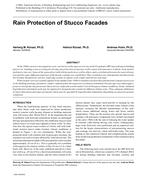Description
In the 1960s extensive investigations were carried out at the open air test site of the Fraunhofer-IBP (specializing in building physics res. building science) testing the driving rain protection of masonry walls coated with innovative synthetic resin renders (polymeric stuccos). Some of the exposed test walls did not perform as well as others, and a correlation between the water absorption and the vapor diffusion properties of the facade coatings was established. This correlation was subsequently introduced into the German Standard for exterior rendering systems in regions with a high wind-driven rain load.
When models were successfully applied in the middle of the 1990s to simulate transient heat and moisture transport processes in the building envelope, parametric studies confirmed that the empirical correlation established 40 years ago was indeed appropriate to classify the rain protection characteristics of facade systems under Central European climate conditions. Today validated hygrothermal calculation tools may be employed to design facade systems for different climate zones. Thus, adequate definitions of water absorption and vapor permeance limits may be specified by hygrothermal simulations depending on expected exposure conditions.
Citation: Thermal Performance of Exterior Envelopes of Whole Buildings IX
Product Details
- Published:
- 2004
- Number of Pages:
- 7
- File Size:
- 1 file , 5.9 MB
- Product Code(s):
- D-BldgsIX85




